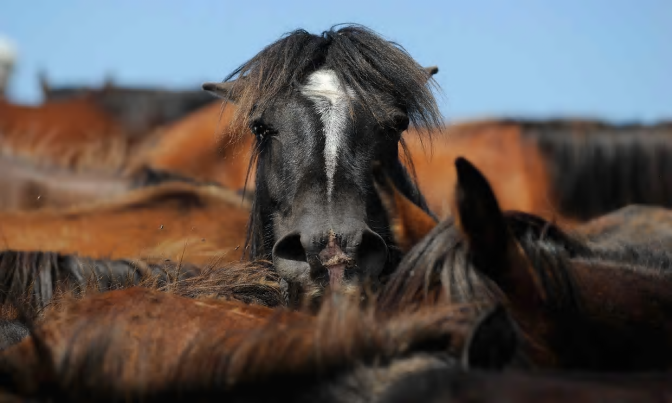Source: The Guardian
Animal welfare advocates left exasperated with Proposition 6, a law that has done nothing to stop California horses from ending up on foreign dinner plates
No horses have been legally slaughtered for human consumption in the US since 2007, when the last operating horse slaughterhouse in Illinois was closed down. Photograph: Denis Doyle/Getty Images
by Daniel Ross
In 2014, Billy Ray Brown Jr, a prolific livestock dealer on the west coast, was charged with buying two old rodeo horses in California, and shipping them to Washington state before selling them to be slaughtered across the border for human consumption.
The case was expected to have far-reaching implications. It was the first time in its 18-year history that someone had been charged under Proposition 6 – an obscure California law intended to crack down on horse slaughter. And the time and resources that the local sheriff’s department had dedicated to the case was unusual for an investigation involving livestock.
But at a preliminary hearing for the case this month, the charges against Brown were dropped, leaving animal welfare advocates exasperated with a law that has done nothing to stop California horses from ending up on foreign dinner plates.
“Tons of horses are crossing the border every week for slaughter. This was the one chance to hold someone accountable,” said Caroline Betts, a University of Southern California professor, and founder of Southern California Thoroughbred Rescue. “I think this will embolden California horse traders. They’ve been getting away with this stuff for 18 years. The law’s well written, but with zero enforcement, it’s meaningless.”
No horses have been legally slaughtered for human consumption in the US since 2007, when the last operating horse slaughterhouse in Illinois was closed down. An effective federal ban on commercial horse slaughter – which essentially pulled funding for inspections of horse slaughter plants – put the brakes on an industry already on the decline. In 1990, nearly 350,000 horses were slaughtered in the US for consumption. By 2006, that number was a little over 100,000.
Welfare was the deciding factor in the ban. Frequently on long journeys to slaughter, horses were crammed tightly without food and water into trucks ill-equipped to haul horses great distances. Many were found fallen and trampled during transit, often resulting in terrible injuries including broken bones. Some died even before they reached the slaughter plants. Other studies linked slaughter plants to high local crime levels and environmental pollution.
In the wake of the 2007 suspension of horse slaughter, Mexico and Canada picked up the slack. According to the US Department of Agriculture, a total of 130,707 horses left the US for slaughter in Canada and Mexico last year, worth an estimated $45.6m of horsemeat combined.
The slaughter industries in both Canada and Mexico have come under scrutiny in recent years. The EU suspended the import of horsemeat from Mexico on the back of a damning 2014 audit that showed how lax identification standards opened the door to banned drugs making their way into the food chain. A subsequent EU audit of Canadian slaughterhouses also raised similar concerns, though no such EU suspension has been enacted against Canadian horsemeat imports as yet.
But the sale of horses for slaughter outside of the US is still widely permitted. Only a handful of states like Texas, New Jersey and Illinois have enacted similar legislation to California’s Proposition 6, attempting to tackle the issue at the state level.
With these laws on the books, animal welfare advocates have hoped to save horses from days-long journeys across the border, and the slaughter practices used in foreign plants. Multiple investigations have found that the captive bolt – a cattle gun method of stunning horses – sometimes fails to render horses unconscious before they’re hung upside down and butchered. Many saw Proposition 6 as an important step towards a federal ban on the export of horses for commercial slaughter altogether.
But it hasn’t worked out that way.
Read the rest of this article HERE.
Categories: Horse News, Horse Slaughter










Horses CAN be slaughtered in the US by their owners AND not for human consumption BUT for zoo meat. It’s a common practice. Even in New Jersey, which you mentioned. Bravo just one example
LikeLike
Reblogged this on hocuspocus13 and commented:
jinxx🔺xoxo
LikeLike
The USDA has approved this horse slaughter plant as a way to get rid of our horses. The main ingredient in most of their products is horse meat. Although I have read that their horse meat comes from Canada, the last time I looked at this Nebraska horse meat company on google earth you could actually see horses in their feed lot outside their slaughter facility buildings.
By the way, a close friend is the manager at a zoo and their animals are NOT fed horse meat and they are healthy. IMO there is NO reason for zoo animals to be fed horse meat!
http://www.nebraskabrand.com/products.htm
Nebraska Brand – PRODUCTS
LikeLike
People think it’s a victory “not for human consumption”. I understand totally how this all works. I live in Roswell, NM and had a mental breakdown during our roller coaster ride. Nothing is solved in a day. This issue won’t be solved in my lifetime. Educate and recruit the young ones now or there surely will be nothing left but to see a horse in a zoo.
LikeLike
It is very sad that these beautiful creatures are just slaughtered to get rid of them.
They do not have to be old, or sick just bought by some one who will slaughter them.
We do need to educate all of their sake, our horses need to be valued not killed.
LikeLike